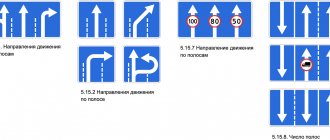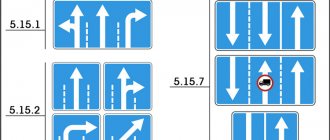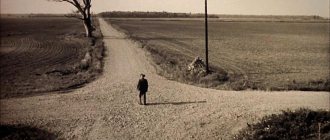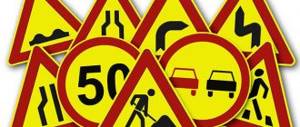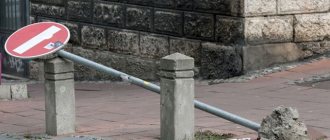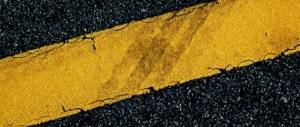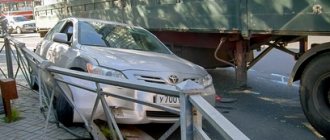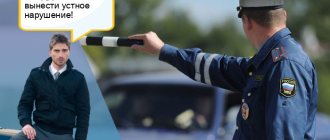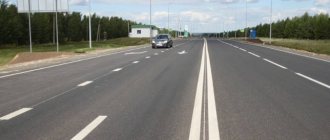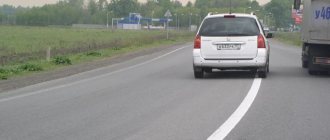4.1.1 Driving straight
Sign 4.1.1 informs about progress according to the arrow pointer (straight ahead). The symbol is relevant on streets with heavy traffic, where even a slight maneuverability of transport can lead to an emergency situation. In addition to this, traffic is explicitly prescribed on narrow roads to avoid congestion.
The functioning of the sign has the following features:
- does not prohibit reversing;
- allows entry into courtyards;
- installed before the fork;
- relevant only for the first intersection;
- does not affect the movement of route transport.
The prohibition of turning left and the absence of intersections of oncoming traffic increases the throughput of the selected section of the route.
How much does it cost to not comply with regulations?
Violation of traffic rules when making turns and u-turns threatens drivers with fines under Part 2 of Article 12.16 of the Administrative Code. The amount of the fine varies from 1000 to 1500 rubles. This wording in the Code of Administrative Offenses reads as follows: turning left or making a U-turn in violation of the requirements prescribed by road signs or markings of the roadway.
The driver may also be held liable under Articles 12.13 and 12.14 of the Administrative Code. Article 12.13 describes penalties for violating the rules for driving through intersections. Entering or crossing an intersection during a traffic jam that forces the motorist to stop and create an obstacle for other vehicles moving in the transverse direction is subject to a fine of 1,000 rubles. This is exactly the traffic rule you can break by trying to make a turn or U-turn within the coverage area of sign 4.1.1.
Drivers often wonder what the fine is for turning left when there is a straight ahead sign? This violation is regulated by Article 12.16 of the Administrative Code and is punishable by a fine of 1000-1500 rubles.
If, together with sign 4.1.1, a turn or other maneuver is prohibited by road markings, the traffic police officer may classify the violation in different ways. In any case, the fine for crossing a solid road when turning is exactly the same - 1000-1500 rubles.
Non-alternative signs
Sign 4.1.2 “Move to the right” indicates movement along the path prescribed by the arrow (to the right).
For example, gas stations are equipped with this symbol to ensure the safe movement of a car entering busy highways and highways. The functioning of the arrow contains nuances:
- You should turn right from the far right lane of the road.
- The symbol is installed before the intersection.
- Action - only at the first fork in the road.
- Not required for route transport.
The last point is especially worth remembering for inexperienced drivers who are repeating the maneuvers of the vehicle in front. Such imitation constitutes a gross offense and a danger of causing an accident. The fine for ignoring a mandatory symbol is set at 1,000 – 1,500 rubles.
Signpost 4.1.3 “Move to the left” determines the route of movement of the vehicle according to the image of the arrow (to the left). The symbol is mounted before the fork in the road and loses its force immediately after it. You should know that a left turn maneuver does not exclude a U-turn.
Sign 4.2.1 “Avoiding an obstacle on the right” gives an idea of how to go around an obstacle (on the right).
The prescriptive nature of the symbol helps to stabilize the road situation when:
- carrying out repair or cleaning work;
- activation of the dividing strip;
- the appearance of a safety island and other things.
If it is possible to go around an obstacle on the left, the driver is not recommended to do this in order to avoid an accident and a fine.
The symbol operates in the area where an object is located that impedes movement. After passing the obstacle, you should return to your lane and drive as usual. Typically, motorists try to avoid obstacles on the right without leaving their lane. But sometimes conditions arise that prevent safe detour. In these cases, the solution to the problem of passing the obstacle is to install the sign 4.2.2 “Avoiding the obstacle on the left.”
The symbol instructs you to go around obstacles on the left edge; accordingly, if it is possible to go around them to the right, this should not be done.
Often, the symbol is equipped with vehicles of municipal and road services responsible for the improvement of streets: repair and cleaning activities, watering of plantings along highways and streets. Sometimes the prescription contradicts the markings, represented by a solid or double solid line. Then one must adhere to the principle of advantage, that is, follow the instructions of the symbol.
The designation “Detour on the left” does not give privileges to the driver in front of vehicles traveling on the opposite path.
Mandatory road signs
Mandatory signs 4.1.1 - 4.1.6
4.1.1 “Move straight”, 4.1.2 “Move right”, 4.1.3 “Move left”, 4.1.4 “Move straight or right”, 4.1.5 “Move straight or left”, 4.1.6 “Move right or left." Driving is permitted only in the directions indicated by arrows on the signs.
Signs that permit a left turn also permit a U-turn (signs 4.1.1-4.1.6 can be used with an arrow configuration corresponding to the required directions of movement at a particular intersection). Signs 4.1.1-4.1.6 do not apply to route vehicles. The effect of signs 4.1.1-4.1.6 extends to the intersection of roadways in front of which the sign is installed.
The effect of sign 4.1.1, installed at the beginning of a section of road, extends to the nearest intersection. The sign does not prohibit turning right into courtyards and other areas adjacent to the road. Since signs 4.1.1-4.1.6 do not apply to route vehicles, their drivers, when maneuvering on the roadway, must be as attentive as possible to other road users for whom these requirements are mandatory.
The effect of signs 4.1.1-4.1.6 extends to the intersection of roadways in front of which the sign is installed
Signs 4.1.1, 4.1.2 and 4.1.4, when used to prohibit left turns, may only be installed above the left lane; on roads with a dividing strip, these signs can only be placed on the dividing strip, and on roads without a dividing strip, when there are no more than two lanes for oncoming traffic, they can be installed only on the left side of the road.
The driver of the vehicle must keep the following in mind. If he has arrived at an intersection with a road that has several carriageways (the carriageways are separated from each other by a dividing strip), then signs 4.1.1-4.1.6 extend their effect only to the intersection of those carriageways in front of which they are installed, that is, they are valid only up to the dividing strip. At the subsequent intersection of roadways, in the absence of signs prescribing restrictions on the choice of trajectory, it is allowed to continue the journey in any direction.
Signs 4.2.1 - 4.2.3 are installed on traffic islands and also in areas where repair work is being carried out on the roadway
Mandatory signs 4.2.1 - 4.2.3
4.2.1 “Avoiding an obstacle on the right”, 4.2.2 “Avoiding an obstacle on the left”. Detour is permitted only from the direction indicated by the arrow. 4.2.3 “Avoiding obstacles on the right or left.” Detour is permitted from any direction. These signs are installed on traffic islands, as well as in areas where repair work is being carried out on the roadway.
Mandatory sign 4.3
4.3. "Roundabout Circulation". Movement in the direction indicated by the arrows is permitted. The sign instructs the driver to move along the intersection (square) in the direction indicated by the arrows before exiting onto one of the adjacent roads.
The sign does not establish a priority in traffic for vehicles moving through a roundabout intersection (the order of passage of each intersection is similar to the general principles of passage of uncontrolled intersections).
The sign should not be used if cross traffic of vehicles, with the exception of rail vehicles, is allowed at the same time as the roundabout.
Mandatory sign 4.4
4.4 "Bicycle path". Only bicycles and mopeds are allowed. Pedestrians can also use the bike path (if there is no sidewalk or pedestrian path). If the lane intended for cyclists is separated from the rest of the carriageway by marking 1.1, sign 4.4 in combination with plate 7.14 must be placed above the lane. If a lane is separated from the rest of the roadway by a curb or barrier, the sign may be installed to the right of the lane.
4.5 pedestrian path is restricted to pedestrians only
The sign must be repeated after each intersection of the bicycle path with the road.
Mandatory sign 4.5
4.5 "Pedestrian path". Only pedestrians are allowed to move. The sign is used to designate a path intended for pedestrians, as well as streets and entire areas completely designated for the movement of pedestrians only (including temporarily, when organizing mass celebrations, etc.).
Mandatory signs 4.6 - 4.7
4.6 “Minimum speed limit.” Driving is only permitted at the specified speed or higher (km/h). The sign is most often used on long climbs to ensure the required speed of traffic flow. For the same purpose, the sign can be used in urban environments with a multi-lane roadway.
If the sign is used without plate 7.14, its effect extends to the entire width of the roadway in a given direction, and if with plate 7.14, then only to the lane above which it is installed. 4.7 “End of minimum speed limit zone.” Indicates the end of the coverage area of sign 4.6.
Mandatory signs 4.8.1- 4.8.3
4.8 “Direction of movement of vehicles with dangerous goods.” The movement of vehicles equipped with identification marks and information plates “Dangerous Goods” is permitted only in the direction indicated on the sign: 4.8.1 - left, 4.8.2 - straight, 4.8.3 - right. These signs must be used to clearly route the movement of vehicles transporting dangerous goods along the road network.
In accordance with Resolution of the Council of Ministers - Government of the Russian Federation dated April 23, 1994 N 372 “On measures to ensure safety when transporting dangerous goods by road,” routes for the transport of dangerous goods must be identified and equipped with appropriate signs in each city.
Alternative signs
There are several signs that provide for variability of choice:
- Symbol 4.1.4 “Move straight or right” determines the course according to the location of the arrows on the sign (straight or right). You must turn right, keeping to the right lane of the highway. The pointer is mounted before the upcoming branching path and is active exclusively on it. The fine for non-compliance with the instructions is 1,000 - 1,500 rubles.
- Pointer 4.1.5 “Move straight or left” sets the vector of movement according to the configuration of the arrows (straight or left). The designation is mounted to the nearest fork and has meaning only for it. The regulation does not apply to route vehicles.
- Sign 4.1.6 “Moving right or left” allows you to choose a route suggested by a combination of arrows (right and left). The rule can be ignored by route vehicles. The symbol can be found before the start of the intersection and followed exclusively at the first fork in the paths. So, signs 4.1.1 - 4.1.6 do not affect the movement of route transport. Signs 4.1.3, 4.1.5, 4.1.6 do not prohibit turning.
- Sign 4.2.3 “Avoiding an obstacle on the right or left” gives a choice of two lines to overcome the obstacle. To avoid getting into the opposite flow, it is preferable to go around the obstacle on the right.
The absence of markings 4.2.1, 4.2.2, 4.2.3 is supplemented by clause 9.12 of the traffic rules, which states: “On two-way roads in the absence of a dividing strip, traffic islands, bollards and elements of road structures (supports of bridges, overpasses, etc.) located on the middle of the roadway, the driver must pass on the right unless signs and markings indicate otherwise.”
Penalty for turning at a straight ahead sign
If there is a sign 4.1.1 at an intersection, you can only go straight there, as well as throughout the entire section where it is in effect. You can only turn into courtyards and adjacent areas. There are also such prescriptive signs.
| Sign number | Name of the sign |
4.1.2 | Movement to the right |
4.1.3 | Driving left |
4.1.4 | Driving straight or right |
4.1.5 | Driving straight or left |
4.1.6 | Moving right or left |
If a sign allows you to turn left, it means you can also turn around. But you can’t turn under sign 4.1.1 at all. Moreover, the punishment is determined by the direction in which the driver turns the car. When turning left or turning the car around when there is a corresponding prohibition, the punishment is regulated by Art. 12.16 part 2 of the Administrative Code, according to which this action is subject to a fine of 1000-1500 rubles. If it is prohibited, but at the same time a right turn is made, Art. 12.16 part 1 of the Code of Administrative Offences, and then the driver is not fined so much - only half a thousand rubles.
If there is a sign 4.1.1, you can only turn into courtyards and gas stations
Important! Thus, fines are distributed to the entire 4.1.1-4.1.6 family. Such nuances, if you study traffic rules insufficiently in depth, are not very noticeable. So, in case of any “misunderstandings”, you need to contact a professional for advice.
Roundabout Circulation
Sign 4.3 “Roundabout” notifies the beginning of a traffic circle:
- when entering the ring, you must slow down the pace of movement;
- movement around the ring occurs exclusively counterclockwise;
- a turn is performed after driving a full circle;
- before the beginning of the roundabout, in addition to symbol 4.3, there are often signs 2.4 “Give way” or 2.5 “Driving without stopping is prohibited”;
- on a ring equipped with traffic lights, participants move according to the permitting signals.
A roundabout looks safer than a traditional one due to the lack of direct intersection of traffic flows. However, accidents happen here too. This happens, first of all, due to ignorance of the principle: the ring is almost always the main road. Some motorists, when entering the roundabout, believe that traffic moving in a circle should let them through, because they are an obstacle to it on the right.
Approaching a roundabout requires the driver to adhere to the posted speed limit, evaluate the symbols present, and follow the traffic rules around the roundabout.
Bike Lane
Sign 4.4.1 “Bicycle path” notifies the beginning of an individual route for cyclists.
The highway is equipped with a lane for two-wheeled vehicles with a maximum speed of no higher than 40 km/h. The designation is mounted:
- to the right of the path, when the demarcation is represented by green spaces and other objects;
- above the track together with the designation 8.14, when the border is marking 1.1.
After forks with highways and alternative routes, the symbol is duplicated.
Sign 4.4.2 “End of the bicycle path” notifies the end of one mode of movement and the beginning of the next. Now cyclists will have to travel on the road along with vehicles. They have to be extremely careful and follow the traffic rules regulating the designated order of movement.
The symbol is installed before the end of the bicycle path or lane.
4.5.1 Pedestrian path
Sign 4.5.1 indicates a section of the route reserved for pedestrian participants. In the field of operation of the symbol, movement and parking of any transport are excluded.
However, the requirement has a number of nuances:
- Vehicles may enter the territory to deliver goods to stores located here. But first, the driver must make sure that there are no other ways to access the store. The driver is obliged to move at a minimum speed, choosing the shortest route through the territory, and also respect the safety of pedestrians.
- Movement in the pedestrian zone is permitted for vehicles of municipal and road maintenance departments operating on this section of the road.
- Cyclists, moped and scooter drivers are allowed to move along the lane after getting off their vehicles.
The symbol is active from the mount point until the fork is overcome.
Mandatory signs: brief description
Let's look at each subcategory next.
4.1.1–4.1.6: "Movement direction"
This is a whole family of signs that allow you to drive only in the direction indicated on the sign. Despite its simplicity, the category has some features:
- Signs “work” only at the road intersection at which they are installed.
- Route vehicles are not covered.
- If the sign indicates, for example, a right turn, then a U-turn is also allowed.
4.1.1 “Move straight ahead” deserves special attention. As the name suggests, the sign only allows you to go straight. But there are a couple of nuances here:
- If a sign is installed in front of an intersection, then it “works” only at that intersection.
- If the sign is placed after an intersection or on any section of the path, then it will extend to the next intersection. In other words, in a particular area only straight driving will be allowed, and any turns will be prohibited. The exception is when turning into the yard or adjacent area.
Reference. It is worth keeping in mind that the signs of this “family” apply to the intersection, and not to the intersection. This is important because an intersection may consist of not one, but several intersections of roadways.
4.2.1–4.2.3: "Detour direction"
They “indicate” to the motorist which side to go around the obstacle.
Reference . If the sign's requirement contradicts the markings, you need to follow the road sign. Even if it is temporary and not permanent.
4.3: "Circular motion"
Indicates with the help of white arrows that traffic in a circle is established in this area (in Russia it is always counterclockwise). Has a number of features:
- Entry is allowed from any lane. In other words, in order to enter the Circle, you do not have to change lanes to the far right.
- You need to leave the Circle taking into account the general rules of maneuvering - from the extreme position on the roadway.
4.4.1, 4.4.2: For cyclists
These signs “say” that a particular section of the path is intended exclusively for cyclists. Designation 4.4.1 indicates the beginning of the track, 4.4.2 indicates its end. Some pedestrians also use the lane for travel. However, this is not recommended - cyclists are capable of developing decent speeds and their “meeting” with a pedestrian can result in dire consequences.
4.5.1: “Pedestrian path”
Indicates an area where pedestrians are allowed to move. If there is no bike path, cyclists can also use it.
4.5.2, 4.5.3: “Combined tracks”
Designate a section of the path on which the joint movement of pedestrians and cyclists is allowed. Designation 4.5.2 indicates the beginning of the track, 4.5.3 indicates the end.
4.5.4–4.5.7: “Tracks with separate movement”
Signs “say” that on a specific section of the road there is a separate traffic for cyclists and pedestrians. Moreover, the separation of the stripes should be highlighted visually. For example, using a lawn, curbstone or other structure.
4.6, 4.7: "Minimum speed"
They limit the minimum permissible speed on a certain section of the road. Designation 4.6 is the beginning of the segment, 4.7 is the end. The implication is that speeds below the recommended speed are prohibited.
4.8.1–4.8.3: “Direction for dangerous goods”
The index covers only those vehicles that transport dangerous goods. “They say” in which direction movement is allowed: 8.1 - straight, 8.2 - right, 8.3 - left. Necessary to limit the movement of vehicles with dangerous cargo in crowded areas, for example in residential areas.
Despite the positive coloring, the actions of prescriptive signs must be carried out in the same way as prohibitive signals. Otherwise, the driver may be subject to administrative penalties.
4.5.2 Pedestrian and bicycle path with combined traffic
Symbol 4.5.2 regulates the movement of pedestrians and bicycle owners along the same line.
The space is also used by owners of mopeds and scooters, since their vehicles have a travel speed below 40 km/h. There is no place for vehicles on the territory of the mandatory sign, except for:
- Vehicles delivering goods to objects in the area where the sign is active (if there are no other access routes);
- special vehicles of various services.
The territory of symbol activity extends from the installation point to the next fork.
Sign 4.5.3 “End of pedestrian and cycle path with combined traffic” informs pedestrians and bicycle owners about the end of a special section and the beginning of a different route plan. Participants should exercise caution when planning and structuring travel routes.
The installation of the symbol takes place on the territory where the general movement ends.
Signs 4.5.4 and 4.5.5 separate the paths for pedestrians and cyclists in the same area. The symbolism tells which row the participants should take. The rows are broken up by a border, lawn or markings.
Signs 4.5.4 and 4.5.5 regulate the end of the previous mode of movement of pedestrians and cyclists. From this moment on, they will have to double their attentiveness and caution, thinking through ways of a safe route.
The symbols are mounted at the end point of the bicycle pedestrian section.
Area for passers-by and people on bicycles
Mandatory road signs that define areas for walking and cycling are often placed outside the road. But every motorist needs to know them. The signs are valid until the first intersection with the road. Violators of these regulations face a fine
Bike Lane
Sign No. 4.4.1 opens the passage only for bicycles. Passers-by use these lanes if there is no other travel option. Scooters and motor scooters can be driven on them if their design features do not allow them to accelerate over 40 km/h.
End of the bike path
Sign No. 4.4.2 indicates the end of the section for cycling.
Footpath
Sign No. 4.5.1 notifies that the territory is suitable for walking.
Special equipment, emergency vehicles, and cargo carriers who deliver products have the right to enter this lane. This exception applies if there is no other travel option for this vehicle.
A pedestrian strip and a zebra crossing are two completely different things. The first one does not belong to the highways, but has its own location.
Pedestrian and bicycle path with combined traffic
The sign informs about the section that is accessible to passers-by, as well as to cycling enthusiasts. Its digital value is 4.5.2.
There are rare situations when vehicles enter under the sign:
- construction, repair;
- emergency rescue measures: extinguishing fires, evacuating victims, etc.;
- delivery of food to nearby stores, canteens or other establishments.
End of the pedestrian and cycle path with combined traffic
Sign No. 4.5.3 notifies pedestrians and cyclists of the end of the section of the path.
Pedestrian and bicycle path with traffic separation
Designation No. 4.5.4 divides the route for pedestrians and cyclists into lanes. The division is made by markings or borders.
Pedestrian and bicycle path with traffic separation
Sign No. 4.5.5 – a copy of sign 4.5.4, with changes in the segments for movement.
End of pedestrian and cycle path with traffic separation
Sign No. 4.5.6 notifies the end of the section of the path marked with the designation 4.5.4.
End of pedestrian and cycle path with traffic separation
Designation No. 4.5.7 notifies the end of the section of the path marked with designation 4.5.5.
The pointers 4.5.4 and 4.5.5 are different. To cancel 4.5.4 you need a 4.5.6 pointer, and to cancel 4.5.5 you need a 4.5.7 pointer.
Minimum speed limit
Sign 4.6 makes it possible to move at a speed not less than the prescribed speed, but not exceeding the permissible traffic rules.
The requirement is relevant for highways with heavy traffic flow, a long overtaking ban and a high probability of congestion:
- The symbol is often combined with other signs, for example, with a sign 8.4 “Traffic lane”, indicating a lane that allows movement at a prescribed pace.
- The use of the sign is legal when there is a nearby road or lane that duplicates the main one. This condition is associated with the movement of low-speed equipment, which can create a traffic jam on the way.
The minimum flow speed is also indicated by the sign 5.15.3 “Start of lane”.
End of minimum speed limit zone
Sign 4.7 signals the end of the activity of symbol 4.6 and returns the ability to move at convenient speed values. It is installed at the end of a section of highway or lane before the end of the minimum speed regulation space. Typically, the designation 4.7 is relevant on highway turns and climbs that limit visibility for the motorist.
And the last point that every car enthusiast should know: mandatory signs are often used together with various symbols of additional information in the form of signs that clarify or limit the effect of these signs. Therefore, such pointers must be read together.
Post Views: 18

